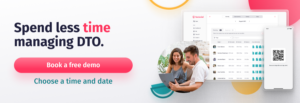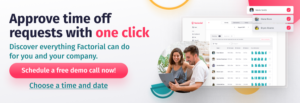In todays fast-paced working environment it is important for all employers to understand what a discretionary policy is and what its benefits or drawbacks are. As hiring highly skilled employees is getting more and more competitive, implementing time off policies is growing in popularity. For employers, offering these policies is becoming a crucial factor in hiring talented new hires. Unlike traditional time-off discretionary time off (DTO) allows employees to manage their absences without constraints or worries and allows employers to retain talent and boost productivity.
Let’s take a look at what discretionary time off is and why you should implement it at your company!
- What is discretionary time off (DTO)?
- Examples of discretionary time off
- What is the difference between discretionary time off (DTO) and paid time off (PTO)?
- Benefits of discretionary time off
- Drawbacks of discretionary time off for employers
- What should be included in a discretionary time off policy?
- Manage time off requests easily with Factorial🚀
What is discretionary time off (DTO)?
Discretionary time off is a type of leave policy that allows employees to request unlimited time off as needed without a pre-defined number of days. This type of leave policy allows employees to take paid time off for vacations, appointments, grievances or personal matters. The employee must get this time off approved by their manager and should give as much notice as they can in advance. However, unlike other leave policies when an employee leaves the company, employers do not pay their employee for the days they have not taken for discretionary time off.
Examples of discretionary time off
Discretionary time off is often a delicate request as it can be linked to personal matters. It is important for employers to be understanding and trustworthy of the employee. Theres are a myriad of discretionary time off requests, the most common being:
Vacation requests
An employee can take discretionary time off for vacation purposes and this is one of the primary uses for discretionary time off. This time off allows employees to take time off to go on vacation without a fixed number of pre-defined days. This prioritizes flexibility and productivity amongst employees which promotes work-life balance.
Sick leave
If an employee falls ill unexpectedly they can take discretionary time off. Unexpected illnesses can disrupt work routines. This type of leave allows employees to recover without worrying about work and how many sick days they have left to take. This ensures that employees prioritize their health and well-being which also reduces the risk of infection in the workplace. Sick leave is one of the most common types of DTO leave.
Personal leave
Sometimes employees have personal matters that demand immediate attention, with DTO an employee can take personal leave. This is often used for employees who have a family member or close friend who is having surgery, needs assistance, or is dying. This allows employees to be flexible and manage important situations in their personal life.
Mental health leave
Employees can take discretionary time off if they are feeling unwell mentally. Mental health is increasingly being recognized as essential for everyones well-being. This can include burnout, overwhelm, depression, anxiety or incase they are in need of a spontaneous break to reset. DTO policies accommodate for mental health needs which shows potential employees that you are an employee-centric company.
What is the difference between paid time off (PTO) and discretionary time off (DTO)?
Discretionary time off (DTO) and paid time off (PTO) both allow employees to take absence from their role at work but they both operate very differently and have varying requirements.
Paid time off (PTO)
- Accrual system: with paid time off employees can accrue days over time from the amount of hours/days they have worked.
- Defined number of days: this policy requires a pre-defined number of days or hours to be approved by the manager before taking a leave of absence.
- Tracked: this time off is tracked by the employer so that they know when an employee will not be working and so that days and hours can be accrued over time.
- Approval process: this time off must be approved by a manager in advance.
- Time carried: paid time off allows employees to carry over their accrued days to the next working year. Although some companies have policies that require employees to use it each year to avoid burnout.
- Payout: once the employee leaves the company they will receive a payout for any days they have not taken while employed by the company.
Discretionary time off (DTO)
- No accrual: employees do not earn accrued days with discretionary time off. It is open to the employee to request and for the manager to approve.
- Undefined number of days: there is no defined number of days for this leave policy. The employee can request to take as much time as they need once approved. The guideline in the US is roughly 3 weeks but it varies for each individual.
- Untracked: this time off is not tracked and monitored like paid time off is.
- Approval process: employees must request approval from their managers to take this leave policy, similar to paid time off, but this is only so that their workload can be taken on by someone else.
- No carryover: with discretionary time off employees are not allowed to accrue time off so they can not carry over any of these days.
- No payout: as there is no carryover or defined amount of days with this leave of absence employees do not receive a payout once they leave the company, unlike paid time off.
Do you want to know more about paid time off (PTO)? Why not check out everything you need to know as a HR employee about PTO or explore employee PTO vs Vacation!
Benefits of discretionary time off
Benefits for employers:
- Attracting talent: having a strong discretionary time off policy is an attractive benefit for talent looking to join a company. This also helps the companies brand as it portrays a progressive and employee-centric work environment.
- Retention rates: by having a strong leave policy that your organization sticks to, employees feel valued and are more likely to trust the company. This lowers the chances that the employee will leave the company.
- Productivity and motivation: employees are more productive and motivated after taking a break from work. If a break is needed the employee can recharge and return to work as a stronger, more focused and efficient addition to your organization.
- Positive work environment: employees will build trust with their team and the overall organization if they know they will be protected in the event that they need to take time off. This contributes to a positive working environment which leads to cooperation and better results overall.
- Prevents burnout: as employees can take this leave to rest and recover when it is needed, they lower the risk of burnout. Burnout is one of the main reasons why employees leave a company.
Benefits for employees:
- Flexibility: this type of leave reassures employees that they can take time off when needed without worrying about running out of days to take.
- Reducing stress: discretionary leave is often taken for personal reasons so this leave allows employees to manage stress levels by removing work for a period of time. As they don’t have to worry about running out of time it gives the employee adequate time to rest and recover if that is what is needed.
- Job satisfaction: working for a company that is employee-centric means that the work environment should be a positive one. This leads to higher morale and job satisfaction amongst employees.
- Promotes work-life balance: as the main reason for discretionary leave is to take time off when you need it, it promotes a healthy work-life balance for employees. This leave allows employees to prioritize their needs for a period of time.
Drawbacks of discretionary time off for employers
- Potential for abuse: some employees could take advantage of this leave and use it for disingenuousness reasons. This can lead to excessive time off which effects the wider teams workload and the results they produce.
- Process management: although discretionary time off does not require tracking, managers must still manage the approvals and processes that allow the employee to take time off. If this process is not automated or streamlined it can be very time-consuming and allows room for error. Factorial’s all-in-one time management software solution manages approvals, time off requests and automates processes to save both employers and employees valuable time, money and resources. Why not book a demo today to save time?
- Workload management: without proper systems in place to manage discretionary time off, there could be inconsistencies and gaps in tasks completed. This causes project delays and disruptions to deadlines.
- Negative team dynamics: if discretionary time off is not properly managed it can lead to other employees becoming frustrated. This leads to resentment among team members and has an impact of morale, teamwork and results.
What should be included in a discretionary time off policy?
A discretionary leave policy should be well-written, clear, comprehensive and designed specifically for your organization’s needs. Here is a list of key elements you should include:
- Clear and comprehensive: ensure that your policy is well-written and easy to follow. This should clearly define what discretionary time off is and list all the requirements that are needed to get approval for this policy. Note: you may need to offer this policy, amongst others, in a myriad of languages for employees working in the US but with other markets or countries.
- Scope: state who is eligible for this policy for example full time employees, part-time employees, probationary period employees, or contractors etc. It is important to specify if remote employees not working in the US are eligible also due to legal and regulatory requirements.
- Guidelines: clearly outline the responsibilities of the employee, the employer and the manager in question for using discretionary time off. Similarly, include details about how to request this time off with their manager. This can include details such as advanced notice, workload cover, limits, restrictions, excessive use, and approval processes.
- Test the policy: ensure that you pilot the policy before implementing it. This will show any gaps in the policy and lower the chances of risk.
- Review and update: finally it is crucial to regularly review and update all policies that your organization implements, including discretionary time off.



